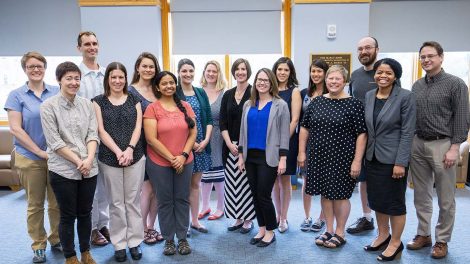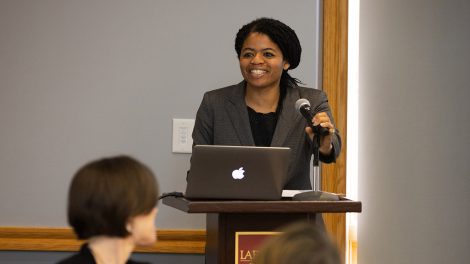Lafayette's Teaching Squares program expands to include faculty from Moravian and Muhlenberg
By Shannon Sigafoos

Tracie Addy, director of the Center for the Integration of Teaching, Learning, and Service
When Tracie Addy, director of Center for the Integration of Teaching, Learning, and Scholarship (CITLS), introduced the Teaching Squares program two years ago, she had a goal of bringing together faculty across several institutions who would benefit from reciprocal peer observation, self-reflection, and group discussion.
While the initial program was successful and proved to enhance the faculty experience, COVID-19 restrictions moved the spring 2021 sessions, observations, and closing reflection to a virtual format, inviting all Lehigh Valley Association of Independent Colleges (LVAIC) instructors who are teaching online or using HyFlex modalities.
Ten faculty members from Lafayette, Moravian College, and Muhlenberg College participated in the program. Their disciplines included theater and dance, English, chemistry, mechanical engineering, electrical and computer engineering, nursing, psychology, and rehabilitation services. Each was put into a group of three or four, and they were exposed to discussions and material outside of their own field. Some participants also observed courses of faculty members in other groups.
During their initial meeting, participants reviewed the program guidelines with their group partners and then scheduled time to take part in sessions that would expose them to a variety of teaching methods and ideas. This allowed the teams to contribute to fostering a culture of ongoing reflection and modification in their teaching practices during the pandemic.
“The Teaching Squares Program continues to provide excellent opportunities for faculty members to network with colleagues and self-reflect on their teaching practices after observing the classrooms of their square partners. This semester, at the recommendation of the CITLS advisory committee, we invited faculty members across LVAIC to participate and to focus on self-reflecting on teaching practices during the pandemic and beyond,” says Addy. “We continue to witness a number of positive outcomes for faculty who participate in the program and are grateful for the opportunity to partner with colleagues across LVAIC this semester.”
Manuela Borzone, assistant director of CITLS, appreciated the connections that are forged across each instructor’s individual specialty.
“Every class is its own small world. Students and instructors develop a common language, build rapport, and become a unique learning community. But seldom do instructors get to travel into other instructors’ worlds. Even within similar disciplines or within the same program, no two classes are ever the same,” reflects Borzone. “The Teaching Squares program provides participants with a window through which to look into another instructor’s small world and reflect on their own teaching. This year, the virtual aspect of the program meant that not only did participants get to visit other classes, they were also able to do it across LVAIC institutions.”
Naga Spandana Muppaneni, assistant professor of electrical and computer engineering—who was paired with her peers in STEM—appreciated the opportunity to divert from a normal classroom experience and appreciated what the online format had to offer.
“This gave us an opportunity to observe and learn from each other’s classes in a virtual environment, which normally doesn’t happen in a regular routine. It’s been quite an enriching experience. It helped me to learn new pedagogical methods from my peers,” says Muppaneni. “I have been brainstorming and planning on how to adapt these methods to improve the quality of my teaching. I greatly appreciate LVAIC and Tracie for organizing such development events for faculty.”
Lauren Myers, associate professor of psychology, also enjoyed having the chance to learn from her colleagues.
“During my first few years on the faculty at Lafayette, I remember feeling envious of my students because they got to experience the classes of all of my amazing colleagues from across campus,” says Myers. “Although my colleagues and I talked about different challenges and opportunities we experienced in our respective courses, I did not get to see firsthand what they did in the classroom. Teaching Squares provided a valuable opportunity to observe classes taught by my talented colleagues, discuss our pedagogy, and learn from one another across different departments, disciplines, and even across the entire LVAIC consortium.”
Teaching Squares participants included: (Group 1) Holly Cate, assistant professor of theater and dance at Muhlenberg College; Joanna Whitney, adjunct professor of theatre and dance at Muhlenberg College; Kathleen Parrish, visiting assistant instructor of English at Lafayette College; (Group 2) Michael Bertucci, assistant professor of chemistry at Moravian College; Daniel Griffith, assistant professor of chemistry at Lafayette College; Toby Rossmann, associate professor of mechanical engineering at Lafayette College; Naga Spandana Muppaneni, assistant professor of electrical and computer engineering at Lafayette College; (Group 3) Kim Wynarczuk, assistant professor of physical therapy rehabilitation sciences at Moravian College; Lauren Myers, associate professor of psychology at Lafayette College; and Pamela Adamshick, associate professor of nursing at Moravian College.


